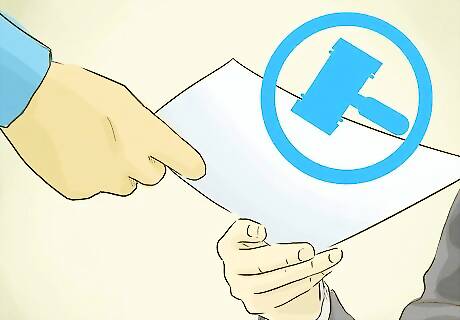
views
X
Research source
- Title your motion and identify yourself in the introduction. Then, say what you want the court to do and state the facts that back up your request.
- Write your legal argument by stating the rule and explaining how your facts apply to it. Then, add your signature, a Certificate of Service, and a Notice of Hearing.
- File your motion with the clerk of court overseeing your case. Then, give copies to each defendant.[2]
Drafting the Motion

Check if the court has blank motion forms. Some courts have "check the boxes" or "fill in the blank" motion forms. Look for these forms on the court's website, or contact the clerk of the court where your case has been assigned. If your court does not have blank motion forms, don't use a blank form from another state. Instead draft your own motion.

Create your caption. Since this is a motion, you should have prior documents in your possession to use as a guide. Look at one of the documents. The heading information is called the caption. Typically, the caption includes the name of the court, the name of the parties, and the case number. This information should always remain in the same form in all documents filed in your case, both in content and format. Simply copy the caption from a previous document into your motion.

Title your motion. Your title should tell the court what the motion is about. If you are asking the court for a default judgment, then your title should be "Motion for Default Judgment." The title should be two lines below the caption, in bold face, centered in the middle of the page. Use a prior document as a guide.

Draft the introductory paragraph to the body of the motion. In the body, you should begin by identifying yourself as either the Plaintiff or the Defendant, and then state whether you are represented by an attorney or making the motion pro se. For example, you could write: "Comes now Plaintiff, Jane Smith, in the above titled action, represented pro per, and moves that the Court…”

Request relief. Every motion is a request for judicial intervention. You want the court to do something. Now, after having laid out your introduction and facts, state what you want the court to do. You should use language like the following: “Now comes Plaintiff, Jane Smith, represented pro per, in the above captioned action, and moves this Court for an order compelling Defendant, Michael Smith, to serve on her a response to Plaintiff’s First Request for Document Production…”

Lay out the applicable facts. After the introduction, state the facts of the case that are relevant to your motion. For example, if the defendant has a copy of a contract in his possession and you want to compel its disclosure, then state, "According to information and belief, the Defendant has in his possession or control a contract executed April 15, 2009 between Plaintiff and Defendant." It may be easier to write out on a piece of paper what you want the court to do. For example, you may want it to postpone a trial because you have surgery scheduled. Or you may want the court to sanction the Plaintiff for not turning over documents requested. After you have done this, you can go back and identify the key facts that are relevant to your argument.

Make your legal argument. The legal argument will differ depending on the motion you file. To make a legal argument, you need to state the legal rule and then explain how the facts you just listed apply to the legal rule. For example, to file a motion for summary judgment, you need to state the summary judgment standard first: "A party is entitled to summary judgment if 'there is no genuine issue as to a material fact and the movant is entitled to judgment as a matter of law. Fed. R. Civ. P. 56 (c)." Then, list what facts the party has to prove: “The Plaintiff’s claim of sex discrimination under Title VII of the Civil Rights Act, 42 U.S.C. sections 2000e et seq., requires that Plaintiff establish, by a preponderance of evidence, an initial showing that: (i) she is female, (ii) she was qualified for the position she held; (iii) she suffered an adverse employment action; and (iv) the adverse action occurred in circumstances giving rise to an inference of discrimination.” Here, you have listed the source of the law (Title VII of the Civil Rights Act, 42 U.S.C. sections 2000e) and the facts the law requires the plaintiff to prove (the four elements, listed i-iv). Then, argue how the facts uncovered during discovery support your position. Here, because the Defendant is arguing the motion, he will argue that the facts show that the Plaintiff cannot prove at least one of the four factors listed. For example, “The Defendant argues that Plaintiff cannot demonstrate a triable issue of fact as to whether she suffered an adverse employment action. Specifically, Plaintiff claims that she was called a 'thief' during a disciplinary hearing. However, an isolated incident of this nature cannot qualify as an ‘adverse employment action.’ because she was never actually disciplined based on that action.”

Insert a signature block. Begin a new paragraph after the body. Include the statement, "I swear the information contained above is true and correct to the best of my knowledge and belief." Include a few blank lines for your signature. Then type your name, address, telephone number, and email address so the court or the other party can contact you. Also insert a notary block. Many states require motions filed by pro se litigants to be signed in front of a notary public. Search the internet for a notary block acceptable for your state, and copy it below your signature block. An acceptable notary certification block might look like this: “I, ______, a Notary Public for the [insert county name] for [insert state] do hereby certify that __________ personally appeared before me this day and acknowledged the due execution of the foregoing instrument. Witness my hand and official seal, this the __ day of ___ 20___.” Then include a line for the Notary’s signature and a line for the date the Notary’s commission expires.

Add a Certificate of Service. You must always notify the other party of any motion that you file, and you must certify that you have served them with a copy of the motion. Two lines beneath the notary block, center the words "Certificate of Service" in bold. Many states have a preferred method. Search your state's form list for a certificate of service and insert the language into your motion. If you can't find a certificate of service specific to your state, then include the following: "I swear that I have [insert method of service, such as mailed/hand delivered/faxed] a true and correct copy of this document to all persons listed below on [insert the date.]"

Include the Notice of Hearing. Some states also have a separate form that they use for this. If you can't find it on your court's website, then insert "Notice of Hearing" about two lines below the Certificate of Service, in the center of the page. Then add: "This motion is set to be heard by ____________ on the ____ day of ____, 20__ in Room ___ of [insert name of courthouse and the address.]"

Sign the motion. If the motion must be notarized, then sign in front of a notary public. Many banks provide notary services free for their customers. You can also find paid notaries at various businesses, such as check cashing companies. Many courthouses also have notary services for a fee. Bring acceptable forms of identification, such as driver's license or a passport.
Filing the Motion

Assemble and copy your motion. If you have any attachments to put with the motion, put those attachments behind your motion. Make a copy of the entire packet for your records and a copy for each defendant. It is best to keep at least 2 copies for yourself in case the court loses a copy. Then you can give the court a copy while still retaining one for your records.

File your motion. Take the original motion with all attachments to the clerk of the court that is hearing your case and give it to him. This is the filing. You should take your copies with you and have them time-stamped as well. By sending a time-stamped copy to the other parties, you signal to them that you have already filed the motion.

Schedule your hearing. While at the clerk's office, ask for a hearing date. If your court has a special method of scheduling motions, then the clerk will let you know. Once your hearing is scheduled, fill in the blanks on the original and all copies of the Notice of Hearing.

Serve your motion. Provide a copy of the motion to each defendant in the same manner that you said you were providing it in the Certificate of Service. Be sure to do this no later than 24 hours after filing your motion. Service by sheriff or by a private process server costs a fee. At the courthouse, you can ask how much service by the sheriff will cost. Private service of process can cost between $20-100. The national average is $45-75.



















Comments
0 comment